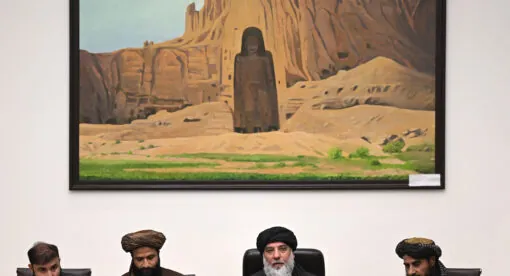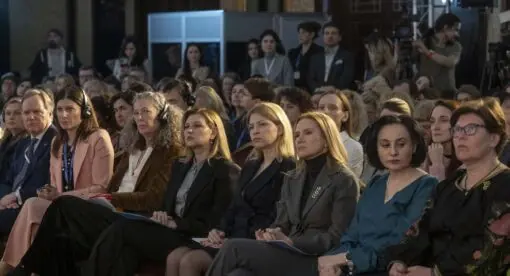Listen to article
The effects of the war between Russia and Ukraine, which entered its sixth month on July 24, have reverberated far beyond the battlefield in Eastern Europe. One result of the standoff between Moscow and the West over Ukraine has been increasing competition and conflict in the energy sphere. While the United States and European Union have enacted sanctions against Russian energy companies in response to Moscow’s military operation in Ukraine, Russia has selectively cut off energy flows to Europe. In the meantime, states like China, India, and Turkey have sought to maneuver around the energy connectivity rift between Moscow and the West, all while attempting to mitigate its most disruptive consequences.
As a result, the world’s leading global and regional players have each developed strategies to strengthen their positions when it comes to energy connectivity, often at the direct expense of others. This has led to an increasingly precarious situation, with energy costs rising as supply flows become strained due to political tensions. Indeed, the European Commission convened an emergency summit in Brussels on July 26 and agreed on a plan to reduce the bloc’s natural gas consumption by 15% as a potentially energy-starved winter approaches.
However, the global competition over energy connectivity does not need to be a zero-sum game, particularly as the world faces the shared challenges of climate change and its increasingly destabilizing impacts. There is much that can be done with the U.S. taking a leading role to address these challenges collectively to offset the economic and political repercussions of climate change, but it is important to first understand the driving forces that shape the energy strategies of the various global and regional powers. From the West to Russia to the world’s major energy importers and exporters, each has unique approaches – and faces unique challenges – to their energy strategy.
The West’s Energy Strategy
For the West, the collective strategy when it comes to energy is fairly straightforward: diversify away from Russian oil and natural gas imports, depriving Moscow of energy revenue. Such revenues not only directly fuel Russia’s military expenditures for its war in Ukraine, but they also give Moscow political leverage over those countries that depend on it for their energy supply. Thus, both the U.S. and EU are seeking to phase out dependence on Russian energy and cut Russia’s massive budget revenues in the process.
This strategy comes with several complications, the first of which is Western countries’ varying degrees of reliance on Russian energy imports. The U.S., for instance, imported just 8% of its oil supply from Russia last year and virtually no natural gas thanks to its shale boom and its rising status as an energy exporter. The EU, on the other hand, is much more reliant on Russian energy supplies, with the bloc importing 27% of its oil and 40% of its natural gas from Russia in 2021 (some countries in Central and Eastern Europe rely even more heavily on Russian energy). As a result, the U.S. was able to ban all oil and gas imports from Russia soon after the invasion, while the EU aims to implement an oil ban by the end of the year and a natural gas phaseout only by 2027.
The second complication is the source of alternative EU energy supplies as a means to achieve diversification away from Russia. While there are other energy exporters that could help the EU replace Russian energy supplies, it will take substantial time and money to develop the necessary infrastructure to significantly wean the Europeans off their dependence on Russia. This is particularly the case for natural gas, as it is much less fungible fuel than oil, with the EU currently importing most of its Russian gas through a vast pipeline network. The bloc has aimed to increase its imports of liquefied natural gas (LNG) – including with help from the U.S. – but LNG is typically more expensive than piped gas, and the Ukraine conflict and its associated disruptions have already pushed up the price of natural gas to record levels in Europe.
The third complication for the West – and one that is intimately related to the issue of rising costs – is political. While the EU and U.S. have so far remained united in maintaining their economic, security, and political support for Ukraine, such support could become increasingly tested as energy and other living costs continue to rise amid the prolonged conflict. This is especially the case for relatively Moscow-friendly countries like Hungary, which have questioned the effectiveness of sanctions and stressed the need for stable energy flows from Russia. Thus, the tolerance for economic pain among the European public (as well as the American public in an election year) will be a key factor in shaping the evolution of the war, particularly as winter draws near.
Russia’s Energy Strategy
As with the West, Russia’s energy strategy is fairly straightforward: to maintain its oil/natural gas revenues as a means to sustain its military expenditures and keep its economy afloat. For Moscow, this strategy rests on a two-pronged approach. The first is to expand its energy exports to non-Western countries such as China and India, which are much less critical of Moscow’s position in the Ukraine conflict and have not enacted sanctions or other economic restrictions against Russia. The second is to drive up the price of energy so that even decreased exports to European countries can allow Moscow to maintain the level of revenues that it received prior to the Ukraine conflict and its attendant restrictions.
So far, this strategy has worked well for Russia. China and India have significantly increased Russian energy imports since the Ukraine conflict began, with the former spending twice as much for Russian energy as it did last year and the latter spending more than five times the amount. Other non-Western states have expressed interest in strengthening their energy relationship with Russia, from South Africa to Iran to Brazil. This shows that, despite its political isolation from the West, Russia does have other options to increase energy ties.
In the meantime, Moscow has ramped up its use of energy as a political tool in Europe. Russia has demanded that EU countries pay for energy imports using rubles to avoid sanctions and economic restrictions, while cutting off energy to “unfriendly” countries that are not willing to do so, such as Poland, Bulgaria, and Finland. Such cutoffs have contributed to rising prices for natural gas, making it easier for Moscow than for the receiving countries to sustain the cutoffs. Indeed, in the first 100 days since the Ukraine conflict began, Russia earned more energy revenues than it did compared to a year earlier prior to the war.
However, Russia’s energy strategy also comes with its own set of complications. While its energy cutoffs to Europe have pushed up prices in the short term, this is not guaranteed to last indefinitely. Both the EU and U.S. are developing alternative sources of energy which are likely to weaken Russia’s leverage in the long run. Additionally, the impact of some of the economic restrictions that the West has placed on Russia’s energy sector, such as technology controls, will take time to develop significance. This could stymie certain Russian energy projects and drive up Russia’s costs for its own energy development.
As for increasing energy exports to non-European sources, Russia faces a challenge similar to what the EU has encountered in its push to develop alternate energy sources: the time and cost of infrastructure development. For example, Russia and China recently signed an agreement to expand the Power of Siberia natural gas pipeline, but construction will not begin until 2024, with supplies set to be delivered by 2030. And with China developing its own green energy technologies and proving to be very cautious when it comes to secondary sanctions exposure, the largest alternative to Europe for Moscow could also be the least dependable in the long run. The question for Russia then becomes whether it is willing to fully divorce itself from Europe as an energy partner, and which side would suffer more as a result over the longer term.
Competing Energy Strategies: Other Key Players
While Russia and the West pursue competing energy strategies, they are not the only influential players shaping the global energy sector. Both the West and Moscow rely on numerous other countries with their own strategic energy approaches as they seek to compete with and diversify away from one another.
As previously mentioned, China has emerged as a major swing player in the energy sphere, so it is important to understand Beijing’s motivations and the challenges it faces in pursuing its energy strategy. China’s strategy has consisted of increasing energy ties with Russia, while doing so in a manner that does not place it in direct conflict with the West. Essentially, China is interested in securing beneficial pricing for Russian energy imports while avoiding any type of cooperation that would make it vulnerable to U.S. secondary sanctions or other threats to its energy security. At the same time, China has been pursuing green energy alternatives and has sought to become a global leader when it comes to renewables like solar and battery-powered energy.
China’s energy connectivity approach has therefore been cautious yet opportunistic: It has increased energy imports from Russia, but it has also been careful not to go too far and risk undue exposure to the West. China’s primary challenge is that while it has emerged as a global economic and energy heavyweight, ultimately it is not in the driver’s seat when it comes to the conflict over Ukraine and its related ripple effects affecting the energy sphere. This makes Beijing dependent on decisions made in Moscow, Brussels, and Washington.
If China is the most important energy importer when it comes to shaping global energy flows (with India also playing an important role as a large market willing to take Russian supplies), a number of key energy exporters could also find increasing importance. While Saudi Arabia plays an important role as a major supplier of global oil supplies, finding alternative suppliers of natural gas will be especially important for the EU. Among possible sources are LNG exporters like Algeria, Norway, and the world’s largest producer, Qatar, which could provide Europe with greater supplies to offset Russian gas imports. However, because it will take several years to substantially ramp up LNG production, and countries in Asia will also be competing for these supplies, without substantial production increases this could further drive up energy prices (and the political costs) for the Europeans.
There are also countries that could increase natural gas exports to Europe via pipeline, including Azerbaijan, Kazakhstan, and Turkmenistan. Indeed, EU Commission President Ursula von der Leyen paid a visit to Baku on July 19 to sign an expanded energy cooperation agreement with Azerbaijan. However, the increase in natural gas supplies (from 8 billion cubic meters/year to 20 bcm/year by 2027) is relatively marginal compared to the EU’s overall needs (Russia supplied 155 bcm to the bloc in 2021). Kazakhstan, and especially Turkmenistan, could also provide significant amounts of natural gas to Europe, but this would require the construction of the Trans-Caspian pipeline, which faces Russian and Iranian political resistance.
Another important and potentially pivotal state when it comes to the energy sphere is Turkey. Ankara has played a delicate balancing act between Moscow and the West, both when it comes to the energy sector and also in broader diplomatic relations. Turkey’s energy strategy has consisted of maintaining its imports of Russian energy while not joining in the West’s sanctions, but it has also leveraged its strategic location as a key transit route offering Europeans an option to bypass Russian energy imports (including from Azerbaijan and potentially Turkmenistan).
However, like China, Turkey is also somewhat beholden to decisions made in Russia and the West when it comes to cutting or redirecting energy flows. And Ankara has also felt the impact of rising energy costs just as the country deals with inflation of nearly 80% and a growing trade deficit. Like much of the rest of the world, this has made Turkey vulnerable to growing economic and political pressures related to the energy sphere that are not fully in its control.
A Path Forward for the U.S. and the World
The increasingly contested energy space has thus led many of the world’s leading players to develop different, and often competing, energy strategies. This competition can often take a zero sum or weaponized approach, with Russia and the West in particular actively trying to undermine one another while others maneuver to take advantage of this competition for their own benefit. Such zero-sum competition is proving to be increasingly expensive for all parties involved, with energy prices going up and politically motivated restrictions becoming the norm.
In the meantime, the summer heat waves throughout Europe and climate events throughout the rest of the world show the costs of maintaining and increasing reliance on fossil fuels as an energy source. With the war in Ukraine only driving the EU and U.S. to reverse their climate commitments and increase their dependence on fuels that create more pollution, like coal, as a stopgap, this is likely to drive the disruptive impacts of climate change even further. And as the Ukrainian conflict shows no signs of abating anytime soon, Europe could reach a breaking point as soon as this winter, with supply shortages possibly leading to industrial shutdowns and a major recession, which would drag down the economies in the rest of the world.
In looking ahead at a more constructive and effective global energy approach, it is important to consider not just the clashing interests of each of the players (be it Russia, the West, China, or the Middle East) but also areas of alignment. And here there are two clear areas in which all of their interests overlap. One shared interest is the prevention of a major energy-fueled economic recession, which would harm everyone involved. The second is to mitigate the even more dangerous consequences of climate change that are looming in the future, with climate events this year serving as a precursor of what’s to come if the status quo is endured.
Thus, it will take collective action in order to prevent and mitigate such dangers, both in preventing the use of energy as a political tool and in investing in and developing green energy and other technologies that can help reduce the world’s carbon footprint. The weaponization of energy only leads to lose-lose scenarios, while competition over energy can be channeled into more constructive forms with a focus on green- and alternative-energy technology development. Thus, the U.S. and the EU should recalibrate their sanctions against Russia in a way that is less disruptive to energy flows to Europe while maintaining pressure against Moscow in areas that have less spillover to the global economy. At the same time, the energy transition should happen in a practical and responsible manner (with a focus on relatively clean transition fuels like nuclear power and natural gas) so as to avoid major disruptions.
Of course, given that energy strategy is a natural outgrowth of national strategy, which inherently focuses on the interests of individual nation-states, it is unrealistic to expect absolute cooperation and reduce all conflict when it comes to the energy sphere. But each country – and especially the U.S. – must prepare for the global impact of climate change, and it is crucial for Washington to work with allies and adversaries alike to mitigate such narrow self-interest to jointly address what is likely to be humanity’s biggest shared challenge in the coming years.
Eugene Chausovsky is Senior Analyst and Program Head, Training and Analytical Products. Previously, he served as Senior Eurasia Analyst at Stratfor for 10 years. His work focuses on political, economic, and security issues pertaining to the former Soviet Union, Europe, and Latin America. He tweets at @EugeneChausovsk.
The views expressed in this article are those of the author and not an official policy or position of the New Lines Institute.






